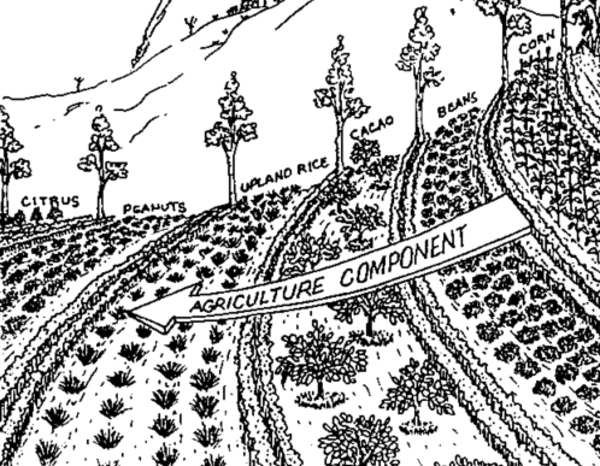
In my first blog post about Transition Forest Gardens I outlined some of my ideas about how to make a forest garden on degraded land. Today’s blog post covers some of my newest ideas for a transition forest garden.
Buy recently moderately-sloped logged land within an hour drive that has a good number of weed trees and other plants such as wild bamboo still growing (not clearcut). Buy the land before the topsoil has washed away. The land may look scruffy, but the topsoil is intact and underground there will be a vast amount of biomass. As the underground biomass dies off, it will release nutrients for new trees, hold moisture like a sponge and create passageways for new roots. I figure it will be 100 times easier growing a forest garden on land like this than on rocky denuded land with little biomass.
The biggest challenge on a larger scale operation like this is it’s not practical to bring in very many external inputs like I’ve been doing for my forest garden. I would have to use ultra-low cost ways to build the soil naturally since the scale of the project is too large (several acres or more).
The main growing system is agroforestry — alley cropping with forest gardens and food crops in the alleyways, and double hedgerows of nitrogen fixing shrubs and trees between. This is similar to the Sloping Agricultural Land Technology (SALT) agroforestry system developed in the Philippines. The SALT details are provided in this free PDF if you don’t mind using SCRIBD.
“The nitrogen fixing plant is seen not as an option to sustainable farming systems but rather as the foundation for the system.” In addition, it would be good to add extra soil building plants in the alleyways. Food crops can be mixed polyculture food forest with patches of corn and other grains, sunflowers, etc. (I would favor primarily food forests for maximum yield and biodversity.)
At the heart of the system is an abundance of nitrogen fixing trees like leucaena and flemingia macrophylia and other dynamic accumulators which are planted from the very start. This includes double rows of leguminous hedges between every alleyway. Let these plants grow for several years and get established. This allows time for topsoil to build up naturally with little effort before the final planting. When the plants are larger they’ll be chopped and dropped for added soil fertility.
Other details:
– keyline cultivation: chisel keylines for the hedges and plants in the alleyways to speed growth and help build topsoil with minimal effort.
– Plant other soil building dynamic accumulators like pigeon pea and vetiver grass in the keylines. Maybe pour in homemade rice hull compost (partially decomposed rice hulls mixed with a little manure and inoculated with Effective Microorganisms) for faster growth.
– note how soil and organic matter builds up behind the hedges over time and gradually form terraces without having to do major earthwork. The hedges also act as mini check dams to slow erosion.
– self-regenerating groundcovers such as sweet potatoes and yams hold and build the soil, stifle weeds and cool the earth.
– thin reeded clumping bamboo like multi-plex is planted around the perimeter for living fence, privacy, livestock barrier, erosion control and future biomass. Brendon at Eco Oasis grinds up this type of bamboo to make homemade compost that’s high in silica – a natural binding material that helps retain nutrients.
– to save labor, make narrow roads on contour between every two alleyways/terraces for small tractors with carts and pickup trucks. Carts and pickups can transport compost, manure and harvested produce. Note how soil amendments can be thrown by hand from vehicles to cover 13’ wide alleyways/terraces on each side. Alleyway dimensions are based on the size of the fruit trees in the forest garden.
– swales: dig small swales by hand or a plow to avoid expensive backhoe fees. The swales could be located on the uphill sides of the narrow roads to minimize road maintenance.
– ponds: swales direct water to ponds that retain water for irrigation during droughts
– there are unlimited possibilities: you could set aside an area for firewood harvesting, grow a large area of sunflowers to make biodiesel, grow most any crops.
Image source
Related article at Permies.com (excellent site) provides food for thought: Restoring cut over/heavily logged land
If there’s huge amounts of forest slash on the ground as in these photos, I’d make hugelkultur beds on contour. Excavate the trenches, fill with branches and leaves, and put the soil on top. The downside to this plan is the high cost of heavy equipment, but maybe it’s worthwhile if you can get the land for a few hundred dollars an acre. One possibility is to buy an old backhoe or tractor and resell it when you’re done.

With reference to: “Hugel beds on contour”
– I used to think they were an amazing Idea too, until I came across this article : http://permaculturenews.org/2015/11/06/dont-try-building-hugel-swales-this-is-a-very-and-i-mean-very-bad-idea/
Still love the site. & Looking forward to the story about restoring degraded land with weeds.
That’s a good reminder to consider the force of water when doing earthquakes. My undergrad degree was in civil engineering so I realize how important this is.
Stay tuned for an interesting story about restoring degraded land with weeds. I knew that weeds are effective at building soil, but the experience I’ve seen first hand in part of our garden is almost too good to be true. It almost seems fake, so I’m going to document what happened. In summary, nature has already devised the most effective soil building methods!